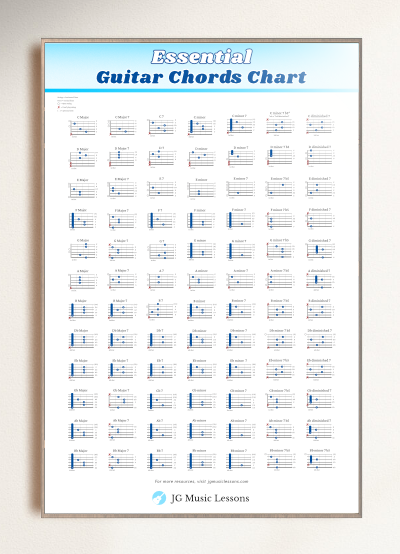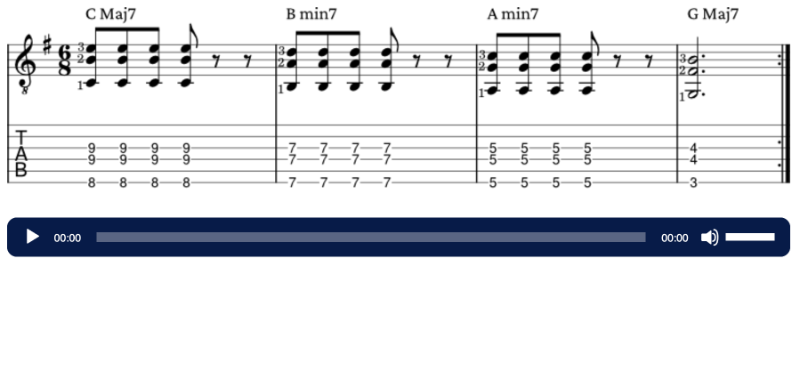Shell chords are foundational shapes that every guitarist should know. These simplified three-note chords highlight the most essential tones in a chord—the root, third, and seventh—giving you a clearer understanding of how chords are built and function.
Because they focus only on the most important notes, shell chords serve as excellent building blocks for creating richer harmonic variations and expanding your chord vocabulary.
In this guide, we’ll break down the theory behind shell chords, explore their shapes on different string sets, and apply them in musical examples with tabs and audio.
Grab your guitar and let’s get started!
*Included in Pro Membership ✨
Shell Chords Overview
Shell chords are simplified three note chords that highlight the important notes in a chord. Shell chords, also known as shell voicings, include the root, 3rd, and 7th chord tones to outline a chord quality. The 5th chord tone is omitted from shell chords since they don’t define the chord quality as distinctly as the other chord tones.
Here’s how different chord qualities are reduced to their essential shell chord tones:
- Major 7 chord – 1, 3, 7. For example: C Major 7: C, E, B
- Major 6 chord – 1, 3, 6. For example: C Major 6: C, E, A
- Dominant 7 chord – 1, 3, b7. For example: C 7: C, E, Bb
- Minor 7 chord – 1, b3, b7. For example: C minor 7: C, Eb, Bb
- Minor 6 chord – 1, b3, 6. For example: C minor 6: C, Eb, A

Guitar Shell Chord Shapes on the 6th string
We’ll start with shell chord shapes starting on the 6th string, and then cover the ones on the 5th string. Here is a quick overview of how to read the chord charts below.
How to read the guitar chord charts
For the following chord charts:
- The lowest horizontal line represents the thickest string (Low E). The top horizontal line represents the thinnest string (high E).
- The numbers inside the blue circles represent the suggested fingering to use on your fretting hand.
- The chord tones are written on the right of each string that is being played.
- Red X indicates not to play a specific string.
If needed, check out how to read guitar notation symbols.
Major 7 Shell Chords – 6th string
You will see two variations of shell chords for each chord quality. One way to order the chord tones is 1, 7, and 3 from the bottom to the top note. The second way is to play them 1, 3, and 7.

Major 6 Shell Chords – 6th string

Dominant 7 Shell Chords – 6th string

Minor 7 Shell Chords – 6th string
For the the 2nd voicing, you can also play it with fingers 3, 1, and 4 from the bottom string up. Use whatever is most comfortable for you.

Minor 6 Shell Chords – 6th string
These shapes are technically the same for fully diminished chords which have a double flatted 7th chord tone (same as a 6th interval).

Guitar Shell Chords on the 5th string
Major 7 shell chords – 5th string

Major 6 Shell Chords – 5th string

Dominant 7 Shell Chords – 5th string

Minor 7 Shell Chords – 5th string
You can also play the 2nd voicing here with fingers 3, 1, and 4 from the bottom string up. Use whatever is most comfortable for you.

Minor 6 Shell Chords – 5th string


Chord Progression Examples using Shell Chords
Here are some musical examples using shell chords including tabs and audio.
Shell Chord Progression Example 1
The first chord progression is in the key of C Major.

Shell Chord Progression Example 2
Here is the same chord progression as the previous except we shift the chords to the key of G Major.
🔒 This section is for Pro Members only

*Included in Pro Membership ✨
Wrapping up
Shell chords simplify chord shapes by emphasizing the most important notes that define a chord’s quality. Despite using only three notes, they produce a rich, compact sound, making them ideal for accompanying vocals or other instruments.
Once you’ve mastered these shapes, you can expand upon them to build more complex chords, such as 7th chords and extensions like 9th, 11th, and 13th chords, which we cover in this lesson on jazz chords.
A great way to internalize shell chords is to practice them in different keys and apply them to real music. Try to use them in songs, experiment with progressions, and listen to how they create harmony. The more you explore, the more naturally they’ll fit into your playing, unlocking new creative possibilities!
📘 Get the free guitar practice guide here!
All the best,
JG Music Lessons
Start Playing Better, Faster
with Pro Membership! ✨
Get the guidance, tools, and support that keep your progress on track:
🏁 Always know what to practice next. Access the full Guitar Learning Roadmap with lessons in sequence.
🎼 Play songs with confidence. Step-by-step lessons of popular, classical pieces and other styles.
📙 Save time and frustration. Clear PDFs and ebooks that save time so you can focus on playing.
🎟️ Get rewarded for consistency. 2 free downloads every month (a $240+ yearly value).
🎁 Keep costs low while you grow. 50% off all charts, tracks, and posters — up to 75% off bundles.
🚫 Stay focused. Ad-free environment keeps you in the zone.
💬 Get help when you need it. Direct member support to keep you on track.


